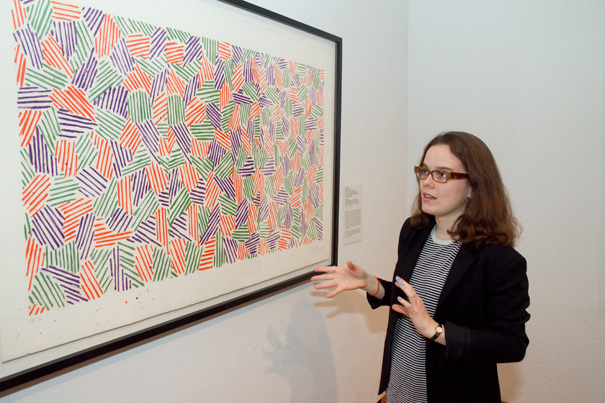
Mary Potter ’12, who helped create the new Harvard Art Museums exhibit on Jasper Johns, discusses his lithograph and woodcut “Scent” (1976).
Jon Chase/Harvard Staff Photographer
Jasper Johns, and a technique he loved
New museum show explores his use of intersecting lines, or crosshatching
In the summer of 2010, Jennifer Roberts agreed to create an experimental course for Harvard College students around a piece in the Harvard Art Museums’ collection, and to explore the potential for a small show.
In the end, those efforts led to a full-fledged exhibition at the Harvard Art Museums/Arthur M. Sackler Museum, developed in tandem with museum officials and four committed undergraduates, that sheds light on the works of one of America’s master contemporary artists.
“Jasper Johns / In Press: The Crosshatch Works and the Logic of Print,” which opened Tuesday at the Harvard Art Museums/Arthur M. Sackler Museum, focuses on the artist’s distinctive crosshatch technique of intersecting lines and the importance of the print medium in his work.
Roberts developed the course as a tutorial, with small seminars that allow for intimate and incisive conversations with students. She and her student team, all juniors with concentrations in the history of art and architecture, took up Johns’ painting “The Dutch Wives,” exploring its relationship to other objects in the museums’ collections and investigating the possibility of creating a show.
“It’s a work that has always intrigued me,” said Roberts, professor of history of art and architecture, and the show’s curator.
After spending hours in front of the painting observing the smallest details, and poring over extensive writings about Johns and his works, Roberts and the students started to brainstorm. “At first, we really had no idea what we were going to do,” said Roberts. But slowly a theme emerged.
They noticed the grid of pencil marks in the work. They discerned the work’s prominent black and white hues, its incorporation of pasted-on strips of newsprint, its almost identical images placed side by side, and Johns’ renowned crosshatch method of bundled parallel lines, based on an ancient printmaking technique used to indicate shading and shadow. The closer the lines, the more shadow is created.
“From that point, we felt that we had a pretty interesting connection that we might want to follow through on,” said Roberts.
With Roberts’ guidance, the students explored the collections, culling the Harvard Art Museums’ extensive holdings of Johns’ prints and drawings. They also drafted descriptive text for the show and created online essays explaining themes in Johns’ work. They even prepared gallery talks that they will deliver during the show’s opening days.
“It was just amazing,” said student Phillip Y. Zhang of preparing the exhibit. “It definitely helped me appreciate what goes into the work that curators do, and it reinforces what we have been doing in terms of getting that very critical perspective on art, and the way we make and consume and present art.”
Many of Johns’ works in the show capture the artist’s ability to stretch the notion of printmaking, like the evocative “Skin with O’Hara Poem.” To create the piece, Johns covered his face and hands with a black greasy liquid known as tusche, rolled them on a lithographic stone, and then pressed a paper to the same surface. The resulting ghostly images seem almost to jump from the paper.
To add historic perspective, the new exhibition also includes works by other artists that illuminate the development of Johns’ style. A work by Pablo Picasso, a master at collage, reveals how Johns’ newsprint creations, the catalog states, “are indebted to Pablo Picasso’s collage experiments.” The inclusion of an engraving by the German artist Albrecht Dürer offers an early look at the use of crosshatching.
“The students had a huge amount of input and say into what actually happened with the show because they were really building it from scratch with me,” said Roberts.
The show was also a useful dry run for what museum officials anticipate with the completion of the renovated home of the Harvard Art Museums. The building on Quincy Street will include 3,000 square feet of curricular gallery space.
“For the first time in the Harvard Art Museums’ history, we will have generous space to experiment in faculty- and student-generated exhibitions,” said Susan Dackerman, the Carl A. Weyerhaeuser Curator of Prints, and the museums’ director of academic programs. “The Jasper Johns project is a model for that. It was our chance to try it out before the new building is finished … and we have found it’s been a great success.”
Dackerman helped to create the show, along with Roberts, Jennifer Quick, a Ph.D. candidate in Harvard Graduate School of Arts and Sciences’ Department of History of Art and Architecture and an Agnes Mongan Curatorial Intern, as well as with students Jacob Cedarbaum, C. Andrew Krantz, Mary Potter, and Zhang.
On a recent walk-through of the show, which runs to Aug. 18, Cedarbaum reflected on the art on the walls and his role in getting it there.
“Professor Roberts presented us with this really unique opportunity to turn the tutorial into something so much more,” said Cedarbaum. “It’s definitely been this amazing, only-at-Harvard kind of experience.”
“Jasper Johns / In Press: The Crosshatch Works and the Logic of Print” will be on exhibit at the Harvard Art Museums/Arthur M. Sackler Museum, 485 Broadway, Cambridge, through Aug. 18.




